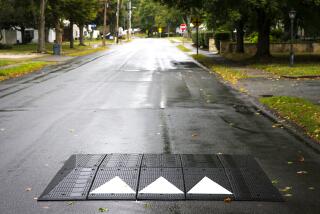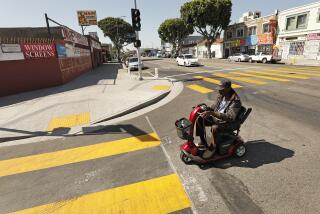Those Speed Bumps Give Flivver the Shivers
At a moment in motoring history that has gone unrecorded, somebody invented the speed bump.
Neighborhoods that want to throttle speeders love the speed bump, and millions of them are going up helter-skelter on roads across the nation.
Many auto safety innovations are carefully researched and regulated. But the speed bump simply happened. And, not surprisingly, speed bumps now come in all shapes and sizes.
The National Highway Traffic Safety Administration has never studied speed bumps. The Federal Highway Administration, which sets road standards, has no regulations governing them.
The philosophy of the speed bump is to irritate drivers by delivering a loud and jarring jolt to vehicles that travel over them too fast. In fact, many speed bumps do far more than irritate drivers. They can damage suspensions, car exhaust systems and parts of the drivetrain.
The vast majority of speed bumps consist of a mound of asphalt that a local traffic engineer deems about the right size. But nobody is quite sure what the right size is.
“Alignments are a problem with the speed bumps,” says Goodyear Tire spokesman Chuck Sinclair. “You certainly have the potential to ruin a tire.”
West Hollywood Transportation Manager Lucy Dyke, who has installed speed “humps” (a more gradual bump) on streets in her city, acknowledges that there are no accepted design standards in the various manuals for uniform traffic control.
Nonetheless, she is a fan of humps.
“People want to find ways to make their streets more civilized,” Dyke says. “Speed bumps are gaining in popularity. People in transportation engineering like them because they are effective in controlling speed.”
But speed bump critics say that no single design can mete out equal justice to all drivers, and in many cases the bumps penalize motorists who are not speeding.
That’s because not all vehicles have the same road clearance, the same type of shock absorbers or the same frame rigidity. So a speed bump may do little to slow down a speeding sport-utility vehicle, but may rip the exhaust system off a 15-year-old Oldsmobile that is going below the speed limit.
Ohio-based Champion American Inc. is among the companies that sell prefabricated speed bumps. But the company does not rate its bumps for speed or offer any guidance on spacing.
John Tye, a California Highway Patrol officer in southern Los Angeles County, says he believes speed bumps being installed in his region are effective in slowing down drivers, but he acknowledges there is valid criticism of the devices.
“It causes problems for fire trucks in responding to calls,” Tye says. “There is some legitimate concern on their part.”
Greg Kelly, owner of Greg’s Automotive of San Diego, says he periodically sees damage inflicted by speed bumps.
“Occasionally you see somebody rip an oil pan loose. There ought to be standards.”
*
* Ralph Vartabedian cannot answer mail personally but will attempt to respond in this column to automotive questions of general interest. Do not telephone. Write to: Your Wheels, 1875 I St. N.W. No. 1100, Washington, DC, 20006, or e-mail to Ralph.Vartabedian@latimes.com.







